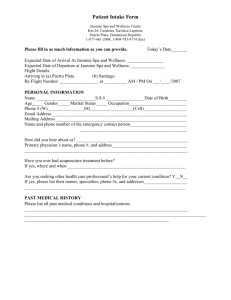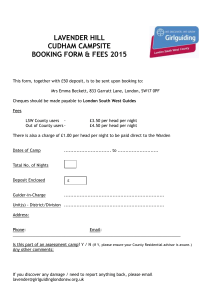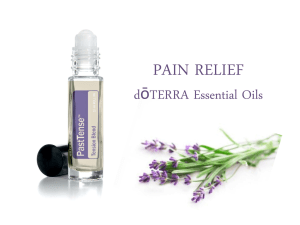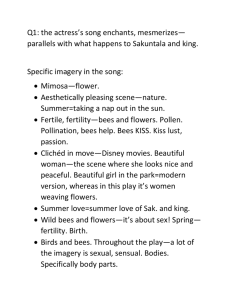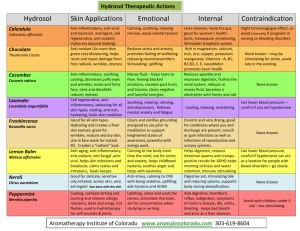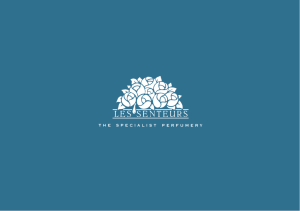Stress Management Techniques (WORD)
advertisement
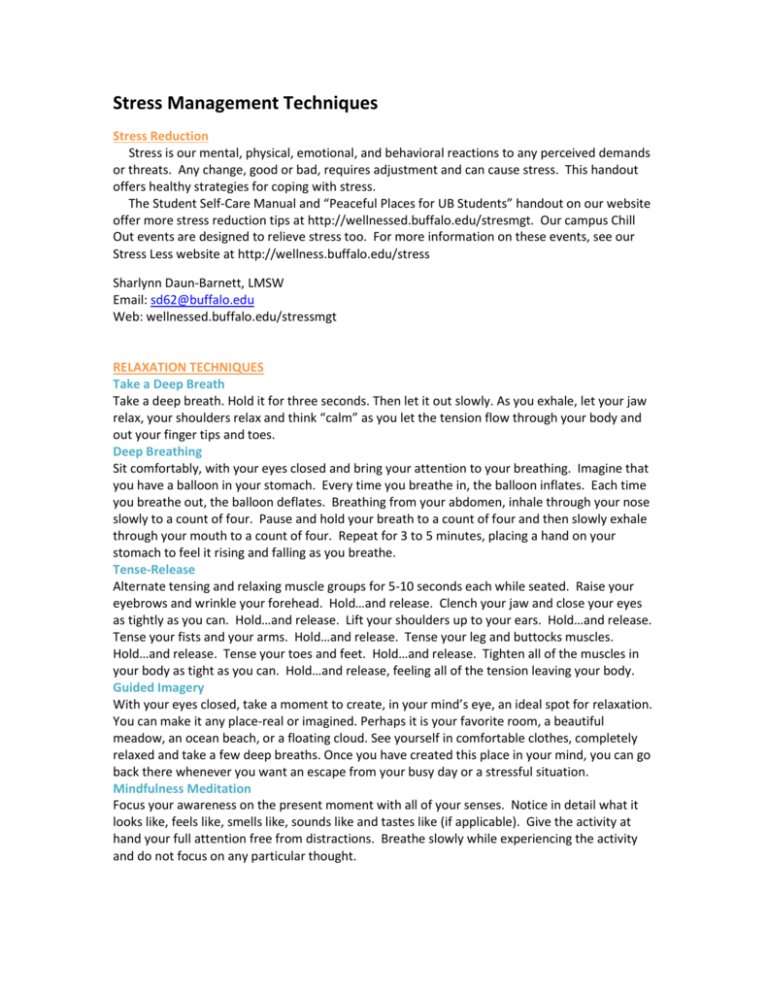
Stress Management Techniques Stress Reduction Stress is our mental, physical, emotional, and behavioral reactions to any perceived demands or threats. Any change, good or bad, requires adjustment and can cause stress. This handout offers healthy strategies for coping with stress. The Student Self-Care Manual and “Peaceful Places for UB Students” handout on our website offer more stress reduction tips at http://wellnessed.buffalo.edu/stresmgt. Our campus Chill Out events are designed to relieve stress too. For more information on these events, see our Stress Less website at http://wellness.buffalo.edu/stress Sharlynn Daun-Barnett, LMSW Email: sd62@buffalo.edu Web: wellnessed.buffalo.edu/stressmgt RELAXATION TECHNIQUES Take a Deep Breath Take a deep breath. Hold it for three seconds. Then let it out slowly. As you exhale, let your jaw relax, your shoulders relax and think “calm” as you let the tension flow through your body and out your finger tips and toes. Deep Breathing Sit comfortably, with your eyes closed and bring your attention to your breathing. Imagine that you have a balloon in your stomach. Every time you breathe in, the balloon inflates. Each time you breathe out, the balloon deflates. Breathing from your abdomen, inhale through your nose slowly to a count of four. Pause and hold your breath to a count of four and then slowly exhale through your mouth to a count of four. Repeat for 3 to 5 minutes, placing a hand on your stomach to feel it rising and falling as you breathe. Tense-Release Alternate tensing and relaxing muscle groups for 5-10 seconds each while seated. Raise your eyebrows and wrinkle your forehead. Hold…and release. Clench your jaw and close your eyes as tightly as you can. Hold…and release. Lift your shoulders up to your ears. Hold…and release. Tense your fists and your arms. Hold…and release. Tense your leg and buttocks muscles. Hold…and release. Tense your toes and feet. Hold…and release. Tighten all of the muscles in your body as tight as you can. Hold…and release, feeling all of the tension leaving your body. Guided Imagery With your eyes closed, take a moment to create, in your mind’s eye, an ideal spot for relaxation. You can make it any place-real or imagined. Perhaps it is your favorite room, a beautiful meadow, an ocean beach, or a floating cloud. See yourself in comfortable clothes, completely relaxed and take a few deep breaths. Once you have created this place in your mind, you can go back there whenever you want an escape from your busy day or a stressful situation. Mindfulness Meditation Focus your awareness on the present moment with all of your senses. Notice in detail what it looks like, feels like, smells like, sounds like and tastes like (if applicable). Give the activity at hand your full attention free from distractions. Breathe slowly while experiencing the activity and do not focus on any particular thought. PHYSICAL ACTIVITY Physical activity increases your overall health and sense of well-being. It also has stress-busting benefits like pumping up your endorphins, improving your mood, providing a break from your stressors and increasing self-esteem. Try to walk or do something active for 20 minutes a day. To gain additional benefits from aerobic and muscle strengthening activities, find a more intense physical activity that you enjoy and do that a few times a week too. SLEEP Good sleep habits reduce stress and help your body recover from stress. Everyone needs a different amount of sleep, however it is recommended to get 7-8 hours of sleep a night. Short naps can also re-energize you and improve your mood. It is suggested that naps not exceed 30 minutes or you may feel groggy. EATING SMART Eating breakfast and eating regularly throughout the day (every 3-5 hours) prepares your body to better cope with stress. Skipping meals should be avoided because it lowers your energy and your ability to focus. Choose more whole and unprocessed foods, and eat a lot of colorful fruits and vegetables to feel your best. MASSAGE Massage is a great way to reduce stress. It releases a hormone called oxytocin, which turns off your stress response and promotes a sense of relaxation. Try to make time for self-massage, exchange massage with a friend, or visit Wellness Education Services for a free 10 minute chair massage once per month. Call 645-2837 for an appointment on North Campus (114 Student Union) or South Campus (Health Science Library and various locations). AROMATHERAPHY Aromatherapy is a scientifically proven technique, which uses your sense of smell to trigger areas in your brain that affect mood. Use the guide below to relieve stress, energize your mind and body, and encourage better health overall. How to Use Aromatheraphy: • Purchase ready-made products in the form of shower gels, lotions, room spray, candles, incense or tea. • Purchase essential oils in the fragrance, personal care or wellness departments of local stores or online. To disperse the scent, heat these with an oil burner or aromatherapy ring, which rests on top of light bulbs. You can also design your own aromatherapy spray. Simply add 10- 15 drops of oil for every ounce of water to a plain spray bottle. To ease these emotions: Aggression Anger Try these herbs or oils: Bergamot, Chamomile, Juniper, Lemon, Marjoram, Rosemary, Ylang-Ylang Chamomile, Jasmine, Marjoram, Rose, Rosemary, Ylang-Ylang Anxiety Disappointment Fear Grief Hysteria Impatience Indecision Jealousy Loneliness Fatigue (emotional and mental) Fatigue (physical) Nervousness Panic Sadness Shock Shyness Suspicion Tension Chamomile, Lavender, Orange, Neroli, Sandalwood Bergamot, Cypress, Frankincense, Jasmine, Orange, Rose Cedarwood, Fennel, Ginger, Patchouli, Sandalwood, Thyme Bergamot, Chamomile, Jasmine, Marjoram, Neroli, Rose Chamomile, Lavender, Neroli, Orange, Tea Tree Chamomile, Clary, Frankincense, Lavender Basil, Clary, Cypress, Jasmine, Patchouli, Peppermint Jasmine, Rose Benzoin, Marjoram Basil, Clary, Coriander, Ginger, Jasmine, Juniper, Orange Palmarosa, Peppermint, Rosemary, Thyme, Vetiver, Ylang-Ylang Basil, Ginger, Lemon, Lavender, Orange, Peppermint, Rosemary Chamomile, Clary, Coriander, Frankincense, Neroli, Orange, Vetiver Chamomile, Clary, Geranium, Jasmine, Juniper, Lavender, Neroli, Ylang-Ylang Benzoin, Jasmine, Rose, Rosewood Lavender, Neroli, Rose, Tea tree Black Pepper, Ginger, Jasmine, Patchouli, Peppermint, Rose, Neroli, Ylang-Ylang Jasmine, Lavender Chamomile, Clary, Cypress, Frankincense, Geranium, Jasmine, Lavender, Lemon, Marjoram, Neroli, Orange, Rose, Rosewood, Sandalwood, Ylang-Ylang FENG SHUI AND CHANGING YOUR ENVIRONMENT Changing your environment can create a sense of calm and help to relieve stress. Feng Shui is the ancient Chinese art that aims to improve your life by rearranging your living space. Use of light, textures, colors and other natural elements can enhance the balance and flow of energy in a room. Suggestions for creating a relaxing environment include getting rid of clutter, bringing something from nature into your room (like a small plant or fountain), using natural light, displaying images and photographs that inspire you, and choosing “cool” colors like purples, blues, and greens for relaxation or “warm” colors like reds, oranges, and yellows for stimulation. This site http://greatist.com/happiness/ultimate-beginners-guide-feng-shui lists step-by-step suggestions on how to Feng Shui a dorm room.

